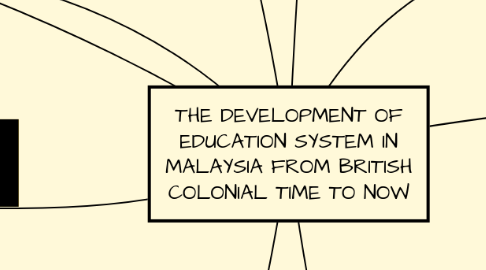
1. All categories of schools, for example, government schools, government-aided schools & private schools;
2. Education act 1996
2.1. Aims
2.1.1. To further consolidate the national education system for the young generation in accordance with the country's aspirations of making Malaysia a center of excellence for education
2.1.2. To outline the legislation related to education
2.2. 3 general legislative provisions:
2.2.1. The National Philosophy of Education which was proclaimed in 1988 & forms the underlying basis;
2.3. The consolidation of the national education system to include the following
2.3.1. All level of schooling, from pre-school until tertiary education;
3. National education policy
3.1. Goals
3.1.1. To produce a united bangsa Malaysia
3.1.2. To produce Malaysian citizens who are knowledgeable, God-fearing, well-behaved, competent & harmonious
3.1.3. To offer equal educational opportunities for all Malaysia citizens
3.1.4. To provide a competent work force to meet the needs of growing nation
4. Compulsory education
4.1. Compulsory for parents to send children to school
4.2. Duration of compulsory schooling is 6 years
4.3. Failure for parents to register their children to school will be fined by the law with RM 5000 or prison sentence not more than 6 months or both
4.4. Reasons:
4.4.1. Various ethnic groups to have equals access to education
4.4.2. Rights of children with poverty are uphold
5. Smart schools
5.1. Rationale:
5.1.1. To achieve Vision 2020 & to keep pace with rapid development in the era of science & technology
5.1.2. The establishment is supported with technology initiative
5.1.3. Promote the development of a work force prepared to meet challenges of the next century
5.2. Concept
5.2.1. A change in the learning culture based on memory & examination-orientation to creative thinking & problem solving
5.3. Goals
5.3.1. To produce a knowledge-based work force who will navigate our country towards an information-based economy
5.3.2. Students will be absorbed into the workforce for the Multimedia Super Corridor
5.3.3. Assist in the transformation of technology ultimately leading to a highly technology-based local industry
6. 1940: Increased number of pupils registered in Malay schools but the British colonial Government did not endeavor to set up Malay secondary school
6.1. British adhered the policy of educating Malay children to become farmers & fisherman only
6.2. Worried that highly educated Malays would initiate anti-British feelings amongst the people
7. Primary & Secondary Education
7.1. Malays were given 6 years of basic education to achieving these objectives:
7.1.1. Provide arithmetic skills for the males to start small businesses upon completion of their edu
7.1.2. Promote awareness regarding the importance of moral values
7.1.3. Ensure the proficiency of children of the royal family in the English language
7.2. Indians - same basic education
7.2.1. After complete their schools - employed as labourers in the rubber estates and railway tracks
7.3. Chinese - autonomy of setting up their own schools and designing their curriculum + employing teachers + text books from China
7.3.1. It was not the British Colonial Government's responsibility to provide education for the citizens of this country. (Resident General of the Federation of Malay States Report, 1901)
8. Development of Malay schools
8.1. British colonial Government enforced the Compulsory Education Act:
8.1.1. Compulsory for parents to send their children to school
8.1.2. Otherwise, they'll be fined
8.1.3. British appealed to the Malay leaders to encourage parents to register their children for schooling
8.1.4. Due to good response, more Malay schools were built
8.2. However, due to small number of Malay parents who willing to send their daughters to school thus took longer time to set up schools for girls
9. Chinese schools
9.1. Founding & funding
9.1.1. Responsibility of the Chinese community
9.1.2. Expenditure for building - businessmen & Chinese leaders
9.2. Education
9.2.1. Teachers brought from China
9.2.2. System based totally from China
9.2.3. Used Chinese dialects
9.3. Chinese revolution 1911
9.3.1. Chinese Government paying attention to Chinese education abroad
9.3.2. Chinese schools frequently visited & monitored by education officers from China
